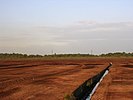Wikipedia:Today's featured article/July 22, 2014
Chat Moss is a large area of peat bog that makes up 30 per cent of the City of Salford, in Greater Manchester, England. North of the River Irwell, 5 miles (8 km) to the west of Manchester, it occupies an area of about 10.6 square miles (27.5 km2). Peat development seems to have begun there at the end of the last ice age, about 10,000 years ago, and the depth of peat ranges from 24 to 30 feet (7 to 9 m). A great deal of reclamation work has been carried out, but a large network of drainage channels is required to keep it from reverting to bog. In 1958 peat extractors discovered the severed head of what is believed to be a Romano-British Celt, possibly a sacrificial victim. Much of Chat Moss is now prime agricultural land, although farming in the area is in decline. A 228-acre (92 ha) area of Chat Moss, notified as Astley and Bedford Mosses, has been designated a Site of Special Scientific Interest. Chat Moss threatened the completion of the Liverpool and Manchester Railway, until George Stephenson succeeded in constructing a railway line through it in 1829; his solution was to "float" the line on a bed of bound heather and branches topped with tar and covered with rubble stone. (Full article...)
Recently featured: Leo Minor – Australian contribution to the Battle of Normandy – McDonald's Cycle Center
